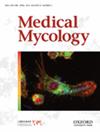探索非隐球菌银耳菌的毒力特性。
IF 2.3
3区 医学
Q3 INFECTIOUS DISEASES
引用次数: 0
摘要
本研究评估了非隐球菌银耳菌Papiliotrema flavescens (n = 5)、Naganishia diffluens (n = 6)、n . randhawae (n = 1)和Filobasidium magnum (n = 2)的毒力特性。毒力性状包括荚膜形成、黑色素生成、脲酶和磷脂酶活性、溶血素生成、生物膜形成和抗紫外线能力。所有酵母生产的胶囊;检出黑色素78.6%,脲酶92.9%,磷脂酶85.7%;42.9%是弱生物膜生产者,33.3%在紫外线照射下存活。这些发现强调了评估的真菌表现出毒力属性,强调了进一步研究的必要性,包括体内研究和遗传分析,以阐明其致病潜力。本文章由计算机程序翻译,如有差异,请以英文原文为准。
Exploring virulence attributes in non-Cryptococcus Tremellomycetes.
This study evaluated the virulence traits of non-Cryptococcus Tremellomycetes Papiliotrema flavescens (n = 5), Naganishia diffluens (n = 6), N. randhawae (n = 1), and Filobasidium magnum (n = 2). Virulence traits analyzed included capsule formation, melanin production, urease and phospholipase activity, hemolysin production, biofilm formation, and UV resistance. All yeasts produced capsule; melanin was detected in 78.6%, urease in 92.9%, and phospholipase in 85.7%; 42.9% were weak biofilm producers, and 33.3% survived UV exposure. These findings highlight that the fungi evaluated exhibit virulence attributes, underscoring the need for further research, including in vivo studies and genetic analyses, to clarify their pathogenic potential.
求助全文
通过发布文献求助,成功后即可免费获取论文全文。
去求助
来源期刊

Medical mycology
医学-兽医学
CiteScore
5.70
自引率
3.40%
发文量
632
审稿时长
12 months
期刊介绍:
Medical Mycology is a peer-reviewed international journal that focuses on original and innovative basic and applied studies, as well as learned reviews on all aspects of medical, veterinary and environmental mycology as related to disease. The objective is to present the highest quality scientific reports from throughout the world on divergent topics. These topics include the phylogeny of fungal pathogens, epidemiology and public health mycology themes, new approaches in the diagnosis and treatment of mycoses including clinical trials and guidelines, pharmacology and antifungal susceptibilities, changes in taxonomy, description of new or unusual fungi associated with human or animal disease, immunology of fungal infections, vaccinology for prevention of fungal infections, pathogenesis and virulence, and the molecular biology of pathogenic fungi in vitro and in vivo, including genomics, transcriptomics, metabolomics, and proteomics. Case reports are no longer accepted. In addition, studies of natural products showing inhibitory activity against pathogenic fungi are not accepted without chemical characterization and identification of the compounds responsible for the inhibitory activity.
 求助内容:
求助内容: 应助结果提醒方式:
应助结果提醒方式:


